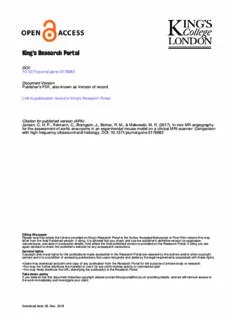
In vivo MR-angiography_JANSEN_Published5June2017_GOLD VoR PDF
Preview In vivo MR-angiography_JANSEN_Published5June2017_GOLD VoR
King’s Research Portal DOI: 10.1371/journal.pone.0178682 Docume nt Version Publishe r's PDF, also known as Version of record Link to publication record in King's Research Portal Citation for published version (APA): Jansen, C. H. P., Reimann, C., Brangsch, J., Botnar, R. M., & Makowski, M. R. (2017). In vivo MR-angiography for the a ssessment of aortic aneurysms in an experimental mouse model on a clinical MRI scanner: Comparison with high-frequency ultrasound and histology. PLoS ONE, 12(6), e0178682. https://doi.org/10.1371/journal.pone.0178682 Citing this paper Please note that where the full-text provided on King's Research Portal is the Author Accepted Manuscript or Post-Print version this may differ from the final Published version. If citing, it is advised that you check and use the publisher's definitive version for pagination, volume/issue, and date of publication details. And where the final published version is provided on the Research Portal, if citing you are again advised to check the publisher's website for any subsequent corrections. General rights Copyright and moral rights for the publications made accessible in the Research Portal are retained by the authors and/or other copyright owners and it is a condition of accessing publications that users recognize and abide by the legal requirements associated with these rights. •Users may download and print one copy of any publication from the Research Portal for the purpose of private study or research. •You may not further distribute the material or use it for any profit-making activity or commercial gain •You may freely distribute the URL identifying the publication in the Research Portal Take down policy If you believe that this document breaches copyright please contact [email protected] providing details, and we will remove access to the work immediately and investigate your claim. Download date: 29. Jan. 2023 RESEARCHARTICLE In vivo MR-angiography for the assessment of aortic aneurysms in an experimental mouse model on a clinical MRI scanner: Comparison with high-frequency ultrasound and histology ChristianH.P.Jansen1☯,CarolinReimann2☯*,JuliaBrangsch2,Rene´M.Botnar1,3,4,5,6, MarcusR.Makowski1,2,3 a1111111111 1 King’sCollegeLondon,DivisionofImagingSciencesandBiomedicalEngineering,London,United Kingdom,2 DepartmentofRadiology,Charite,Berlin,Germany,3 BHFCentreofExcellence,King’sCollege a1111111111 London,London,UnitedKingdom,4 WellcomeTrustandEPSRCMedicalEngineeringCenter,King’s a1111111111 CollegeLondon,London,UnitedKingdom,5 NIHRBiomedicalResearchCentre,King’sCollegeLondon, a1111111111 London,UnitedKingdom,6 SchoolofEngineering,PontificiaUniversidadCatolicadeChile,Santiago,Chile a1111111111 ☯Theseauthorscontributedequallytothiswork. *[email protected] Abstract OPENACCESS Citation:JansenCHP,ReimannC,BrangschJ, BotnarRM,MakowskiMR(2017)InvivoMR- angiographyfortheassessmentofaortic Background aneurysmsinanexperimentalmousemodelona MR-angiographycurrentlyrepresentsoneoftheclinicalreference-standardsfortheassess- clinicalMRIscanner:Comparisonwithhigh- mentofaortic-dimensions.Forexperimentalresearchinmice,dedicatedpreclinicalhigh- frequencyultrasoundandhistology.PLoSONE12 (6):e0178682.https://doi.org/10.1371/journal. fieldMRIscannersareusedinmoststudies.ThistypeofMRIscannerisnotavailablein pone.0178682 mostinstitutions.TheaimofthisstudywastoevaluatethepotentialofMR-angiographyper- Editor:DavidePacini,UniversitadegliStudidi formedonaclinicalMRscannerfortheassessmentofaorticaneurysmsinanexperimental Bologna,ITALY mousemodel,comparedtoapreclinicalhigh-resolutionultrasoundimagingsystemand Received:January20,2017 histopathology. Accepted:May17,2017 Methods Published:June5,2017 AllinvivoMRimagingwasperformedwithaclinical3TMRIsystem(PhilipsAchieva) Copyright:©2017Jansenetal.Thisisanopen equippedwithaclinicalgradientsystemincombinationwithasingle-loopsurface-coil(47 accessarticledistributedunderthetermsofthe CreativeCommonsAttributionLicense,which mm).AllMRsequenceswerebasedonclinicallyusedsequences.Forultrasound,adedi- permitsunrestricteduse,distribution,and catedpreclinicalhigh-resolutionsystem(30MHzlineartransducer,Vevo770,VisualSonics) reproductioninanymedium,providedtheoriginal wasused.AllimagingwasperformedwithanApoEknockoutmouse-modelforaorticaneu- authorandsourcearecredited. rysms.Histopathologywasperformedasreference-standardatallstagesofaneurysm DataAvailabilityStatement:Allrelevantdataare development. withinthepaper. Funding:ThestudywasfundedbytheBritish Results HeartFoundationwww.bhf.org.uk(PG/09/061)and theDeutscheForschungsgemeinschaft[http:// MR-angiographyonaclinical3Tsystemenabledtheclearvisualizationoftheaorticlumen www.dfg.de/](MA5943/3-1/andMA5943/4-1/9- andaneurysmaldilationatdifferentstagesofaneurysmdevelopment.Aclosecorrelation 1).Thefundershadnoroleinstudydesign,data (R2=0.98;p<0.001)withhistologicalareameasurementswasfound.Additionally,agood collectionandanalysis,decisiontopublish,or preparationofthemanuscript.Otherwise,thereare agreementbetweenMRandultrasoundareameasurementsinsystole(R2=0.91;p< PLOSONE|https://doi.org/10.1371/journal.pone.0178682 June5,2017 1/14 InvivoMRangiographyonaclinicalMRscannerfortheassessmentofaorticaneurysms nofinancialorotherrelationsthatcouldleadtoa 0.001)anddiastole(R2=0.94;p<0.001)weremeasured.Regardinginterobserverrepro- conflictofinterest. ducibility,MRImeasurementsyieldedasmaller95%confidenceintervalandacloserinter- Competinginterests:Theauthorshavedeclared readercorrelationcomparedtoultrasoundmeasurements(-0.37–0.46;R2=0.97vs.-0.78– thatnocompetinginterestsexist. 0.88;R2=0.87). Conclusion ThisstudydemonstratesthatMR-angiography,performedonaclinical3TMRscanner, enablesthereliabledetectionandquantificationoftheaorticdilatationatdifferentstagesof aneurysmdevelopmentinanexperimentalmousemodel. Introduction Cardiovasculardiseases,includingaorticaneurysms,currentlyrepresentthemaincauseof deathinWesternsocieties.Especiallytheincidenceofabdominalaorticaneurysms(AAAs)is steadilyincreasing,especiallyinthelast20years[1,2].Oneofthemainfactorsforthisincrease inincidenceistheprogressiveagingofthegeneralpopulation.Currentlytheincidenceof abdominalaorticaneurysmsisestimatedtobearound5%inthegeneralpopulationolderthan 50years[3,4].Thedevelopmentofabdominalaorticaneurysmsisassociatedwithdifferent causes,whichincludeaorticinfection,disordersofconnectivetissuesandtraumaticevents[5, 6].However,inmostcases,theexactinitiatingeventandpathophysiology,underlyingthe developmentisnotfullyunderstoodyet[7].Inmostcases,abdominalaorticaneurysmsare associatedwithaprogressivedilationoftheaorticlumen.Ifthisprocesscontinues,abdominal aorticrupturewithfatalconsequencescanbetheresult[8]. Inclinicalpractice,thescreeningforandtheevaluationofabdominalaorticaneurysmscan beperformedusingdifferentimagingmodalities[9].Theseimagingmodalitiesincludemagnetic resonanceimaging(MRI),computedtomography(CT)andultrasound(US).Eachimaging techniqueisassociatedwithspecificadvantagesanddisadvantages.MRIisuniqueinasensethat itenablesthehigh-resolution3Dvisualizationoftheaortawithouttheneedforcontrastagentor ionizingradiation.ThemaindisadvantageofMRIistherelativelylongscantime,comparedto e.g.CT.ThemainadvantageofCTisthatimagingcanbeperformedwitharelativelyhighspatial resolutioninashorttime,howeverCTangiographyisdependentontheuseofiodinatedcon- trastagents.Ultrasoundhastheadvantage,thatitisawidelydistributedimagingtechniqueavail- ableinmostclinicalcenters.Oneofitsmaindisadvantagesistheoperatordependence,whichis especiallyrelevantinthecontextoffollowupexaminations. Inmagneticresonanceimaging,differenttechniquescanbeusedforthevisualizationof vessels[9].AsMRcontrastagentshavebeenrecentlylinkedtosideeffectssuchasnephrogenic systemicfibrosis(NSF),non-contrastenhancedtechniquesaregaininginpopularity[10].In anexperimentalsettingwithsmallanimals,suchasmice,non-contrastenhancedtechniques haveseveraladvantages.Themainadvantageisthatimagingcanberepeatedlongitudinallyat limitlesstimepointsinasingleanimalwithouttheneedforintervention. Experimentalmousemodelsarethemostwidelyusedanimalmodelsforthepreclinical investigationofdiseases[11].Thesemodelsenableresearcherstoinvestigatethedevelopment ofdiseasesandtheinfluenceofgeneticmodulationorpharmacologicaltherapiesondisease development.Additionally,mostnoveldrugsareinitiallytestedandvalidatedinanimalmod- elspriortoclinicaltrials.Formostpreclinicalstudies,histologicalanalysisisperformedto evaluateandquantifyinvivochanges.However,noninvasiveimagingtechniquesaregaining PLOSONE|https://doi.org/10.1371/journal.pone.0178682 June5,2017 2/14 InvivoMRangiographyonaclinicalMRscannerfortheassessmentofaorticaneurysms inimportance.Themainadvantageofsuchanapproachisthatthenumberofrequiredani- malsforastudyisdramaticallyreduced. Inthiscontextmorphologicalaswellasmolecularimagingmethods,includingPET(posi- tronemissiontomography),SPECT(single-photonemissioncomputedtomography),MRI, CTandultrasoundarethemostfrequentlyusedtechniques.Inthisgroupofmodalities,MRI hasseveraladvantagesincludingauniquesofttissuecontrastincombinationwiththe3D acquisitionofmorphologyandfunction[12,13].ThemajorityofMRIstudiesinmiceareper- formedwithdedicatedpreclinicalscannerswithanultra-highfieldstrength(4.7–16.4Tesla). Manyinstitutionsdonothavethesekindofpreclinicalimagingsystemsavailableasitusually requiresdedicatedpersonnel,includingMRphysicists,torunandmaintainthesesystems. Advantagesinhardwaredevelopmentandsequencedesignhavemadeitpossibletoperform smallanimalimaginginclinicalMRIscanners. Inthisstudy,weevaluatedthepotentialofawidelyavailableclinical3TtheMRIsystemfor theassessmentofaorticaneurysmdevelopmentinamousemodel.Weusedthemostfre- quentlyinvestigatedandbestvalidatedmousemodel,whichisbasedontheApoE-/-mousein combinationwithangiotensinIIinfusion[14–17].Suchamousemodelishighlyrelevantas abdominalaorticaneurysmsrepresentacardiovasculardiseasewithseverecomplications. Manyaspectsofthisexperimentalmodelarecomparabletohumandiseaseincludingan increasedincidenceofhyperlipidemia[14].Besideshyperlipidemia,otherfactorssuchas hypertensionandcysticnecrosisoftheaorticwallalsoplayanimportantroleduringthedevel- opmentofaorticaneurysms.Especiallyinthecontextofthoracicaorticaneurysms,apotential associationwithcysticmedialnecrosishasbeendescribedbypreviousstudies[18,19]. Theaimofthisstudywastotestthepotentialandreliabilityofaclinical3TMRIsystemfor theperformanceofMR-angiographyinamousemodelofaorticaneurysm,comparedtoa dedicatedpreclinicalhighresolutionultrasoundimagingsystem.Histologicalanalysiswas usedasreferencestandard. Methods Setupofanimalexperiments ThisstudywascarriedoutinstrictaccordancewiththerecommendationsintheGuideforthe CareandUseofLaboratoryAnimalsoftheUnitedKingdomHomeOfficeandisregulated undertheAnimalsScientificProceduresAct1986(ASPA).ASPAhasrecentlybeenrevisedto transposetotheEuropeanDirective2010/63/EUontheprotectionofanimalsusedforscien- tificpurposes.TheprotocolwasapprovedbytheCommitteeontheEthicsofAnimalExperi- mentsoftheKing’sCollegeLondon.Allanimalexperimentsinthisstudywereperformedin accordancewiththeseinternationalregulations.Allinterventionwasperformedwithacombi- nationanesthesia(Medetomidin,Midazolam,Fentanyl),andalleffortsweremadetominimize suffering.Osmoticminipumps(Alzetmodel2004,DurectCorporation,Cupertino,CA,USA) wereimplantedintoeightweeksoldmice.Forthisstudy,homozygouseightweeksoldC57BL/ 6JApoE-knockoutmice(male)fromtheCharlesRiversLaboratorieswereused.Theanimals werefedwithastandardlabdietandhousedinacleanbarrier.Theminipumpswereloaded (loadingwasperformedassuggestedbythemanufacturer)exvivowithAngII(Sigma-Aldrich, SaintLouis,MO,USA,),implantedsubcutaneouslyinthedorsalregionunderacombination anesthesia(500μg/kgMedetomidin,50μg/kgFentanyl,5mg/kgMidazolam)andinfuseda continuouslydoseof1microgramkg-1min-1intothemice[15,20].Atweekone,two,three andfourafterAngIIinfusionMRIimagingwasperformedandvesselswereharvestedforhis- tologicalanalysiseachweek(n=8pergroup).Asham-operatedgroup(controlgroup,n=6) werealsoimplantedminipumpswhichinfusedsalineforfourweeks.Eightmicewerescanned PLOSONE|https://doi.org/10.1371/journal.pone.0178682 June5,2017 3/14 InvivoMRangiographyonaclinicalMRscannerfortheassessmentofaorticaneurysms byMRIateachtimepoint.allanimalsweresacrificedforfurtherhistopathologicalanalysis afterthefinalimagingsessions.Fortheimagingsession,micewereanesthetizedwithanintra- muscularapplication[21,22]ofthesamecombinationofMedetomidin,Fentanyl,Midazolam asmentionedabove.Inallmicewithabdominalaorticaneurysm,anexsanguinationinante- riorperfusionwithphosphatebufferedsaline(100mmHg)wasperformedfollowingtheMR imagingsession.Thiswasfollowedbyaperfusionwith10%formalinifvesselsampleswere usedforhistology.Aorta,rightrenalarteryandthelastpairofintercostalarterieswasexcised toallowanatomicalmatchingduringhistopathologicalprocessingofthesamples. Animalhandlingandinvivomagneticresonanceimaging Eachanimalwasinanesthesia(asdescribedearlier)andplacedinapronepositiononasurface microscopycoil(Philipshealthcare,Best,theNetherlands).Allimagingwasperformedusinga clinical3TAchievaMRsystem(PhilipsHealthcare,Best,TheNetherlands).Agradientsystem withagradientstrengthof30mT/mandaslewrateof200T/m/swasused.Forthesequence acquisition,adedicatedsoftwarepackageforcardiacimagingwasavailable.Thesignalwas gainedusingamicroscopysingleloopcoilwithaninnerdiameterof47mm.Thecoilwas placedinthemagneticcenteroftheboreoftheMRI.AnMRcompatiblebodytemperature monitoringandheatingsystemwasusedtomaintainthetemperature(37ºdegreesCelsius)of allanimalsduringtheentireacquisitionoftheMRdatasets(Model1025,SAInstruments Inc.,StonyBrook,NY).AllMRimagingsequenceswerebasedonclinicalMRsequences.The imagingprotocolincludedthefollowingsequences.AtthebeginningofaMRimagingproto- colalow-resolutionscoutsequence(three-dimensionalgradientechosequence)wasusedto forananatomicaloverviewandlocalizationoftheabdominalaorta.Thescoutscanwasper- formedinthecoronalandtransverseorientationusingthefollowingparameters:field-of-view (FOV)=200mm,matrix=320,slicethickness=2mm,TR/TE=20/5.8ms,flipangle=30˚ andslices=9.Followingatransverseorientationofatwo-dimensionaltime-of-flightangiog- raphy(2DTOF)wasexecutedforaprecisevisualizationoftheabdominalaorta.The2Dtime- of-flightsequencewasplannedtoincludetherenalarteriesasanatomicallandmarksinall scans.Theimageparametersincluded:Slicethickness=0.5mm,inplanespatialresolution=0.3 x0.3mm(reconstructed0.13x0.13mm),imagingmatrix=160x160,fieldofview=20x20x 10mm,flipangle=60˚,echotime(TE)7.7msandrepetitiontime(TR)sequence=37ms. Fold-oversuppressionwasactivated.Fold-overdirectionwasrighttoleft.Acartesianacquisi- tionmodewasused.Amaximumintensityprojection(MIP)ina360-degreereconstruction wasautomaticallyreconstructedbasedonthetime-of-flightangiography(Fig1). Magneticresonanceimageanalysis Signaltonoisemeasurements(SNR)wereperformeddirectlyproximaltotherightrenalartery inthecontrolgroup(shamgroup,Fig1).TherightrenalarterywasclearlyvisibleinallMR scans.Ifananeurysmwaspresent,signaltonoisemeasurements(SNR)wereperformedatthe locationofthemaximalareasize(Fig2).MRimageanalysisofDICOMimageswasperformed usingtheopensourceversionofOsiriX(version7.1,OsiriXfoundation).Timeofflight(TOF) imageswereusedtolocalizeaorticaneurysms.Regionofinterests(ROIs)weremeasuredas areasofsignalenhancementonTOFimagesfortheevaluationofsignalintensity.Regionof interestsweredrawntodelineatethecompletevascularlumenforareproduciblemeasure- ment.FortheROIssignaltonoiseratio(SNR)wascalculatedwithfollowingformula:Signal tonoiseratioMR-angiography(MRA)=((aneurysmal)aorticlumensignal)/(standarddevia- tionlumensignal).Suchanapproachwaschosentoallowforcomparabilitybetweentheanal- ysismethodsforMRandultrasound. PLOSONE|https://doi.org/10.1371/journal.pone.0178682 June5,2017 4/14 InvivoMRangiographyonaclinicalMRscannerfortheassessmentofaorticaneurysms Fig1.VisualizationoftheabdominalaortainacontrolmousebyMR-angiographyonaclinicalMR systemincomparisontohigh-frequencyultrasound.Imagesdemonstratethevisualizationofthe abdominalaortainasham-operatedApoE-/-mousebyinvivoMR-angiographyonaclinicalMRsystem(A) anddedicatedhigh-frequencyultrasound(C)incomparisontohistology(B).ThereconstructedTOF angiogram(A1,maximumintensityprojection(MIP))ofthesuprarenalpartofthenondilatedabdominalaorta isshown.RedlinesindicatetheorientationofsubsequentlyperformedtransverseMRIsequences(A2,A3, A4).Correspondingexvivohistologicalsections(B1-B6),ElasticavanGieson(EvG)stain(B1,B2,B3), hematoxylineosin(HE)stain(B4,B5,B6)demonstrateanondilatedabdominalaortaatdifferentlevels(red lines).High-frequencyultrasoundimages(C)ofanabdominalaortausingadedicatedimagingsystem(Vevo 770).Correspondinglongitudinal(C4)andtransversalimagingplanes(C1,C2,C3)areshown. https://doi.org/10.1371/journal.pone.0178682.g001 Invivohigh-frequencyultrasoundimaging Highresolutionultrasoundimagingwasperformedwithanimalsplacedonaautomatically heatedtable(37˚)insupineposition.Priortoultrasoundimaging,allanimalsweredepilated withhairremovalcream.Forultrasoundmeasurements,aVevo770ultrasoundimagingsys- tem(VisualSonics,Toronto,Canada)witha30MHzlinearsignaltransducerwasused.For Fig2.EvaluationoftheabdominalaortainanApoE-/-mousebyMR-angiographyonaclinicalMR systemandhigh-frequencyultrasound.EvaluationofanabdominalaorticaneurysminanApoE-/-mouse byinvivoMRIandultrasound4weekaftercontinuousinfusionofangiotensinII(4-weekgroup).Themaximum intensityprojection(MIP)ofthetime-of-flight(TOF)angiogram(A1)demonstratesasignificantlydilatedaortic lumen.Thelocationoftransverseslices(A2,A3)aredepictedbytheredlinesinA1.Correspondingexvivo histologicalsections(ElasticavanGieson(EvG)stain(B1,B2),hematoxylineosin(HE)stain(B3,B4)confirm thedilationoftheaorticlumen.MagnificationsofB2andB4highlightthesiteofruptureoftheelasticlaminaein thetunicamediaoftheaortainEvGstainandHEstain.Correspondingultrasoundimagesofabdominalaorta usingthededicatedhigh-frequencyUSimagingsystem(Vevo770)insagittal(C3)andtransversalorientation (C1,C2). https://doi.org/10.1371/journal.pone.0178682.g002 PLOSONE|https://doi.org/10.1371/journal.pone.0178682 June5,2017 5/14 InvivoMRangiographyonaclinicalMRscannerfortheassessmentofaorticaneurysms imagingandanatomicalcolocalizationthesuprarenalabdominalaortamorethan20dynamic 2D-transverseandsagittalimageswereacquiredinallanimals.Cinetransversalandsagittal imageswerereconstructedbytheECG-basedkilohertzvisualization(EKV)technique.The resultingimageswereanalyzedduringend-diastoleandduringend-systole. Analysisofinvivohigh-frequencyultrasoundimaging Signaltonoisemeasurements(SNR)wereperformedinthesameanimalatthesamelocationas MR-angiographymeasurements.Ifananeurysmwaspresent,measurementswereperformedat thelocationofthemaximalareasize.Ifnoaneurysmwaspresent,measurementswereper- formeddirectlyproximaltotherightrenalartery.Toobtaincomparablemeasurementsbe- tweenMRIandultrasounddatasetscomparabletechniquesfortheassessmentoftheSNRwere applied.Regionofinterests(ROIs)weremeasuredasareasofsignalenhancementofluminal aorticsignal.Theregionofinterestweredrawntodelineatethecompletevessel.FortheROIs signaltonoiseratio(SNR)wascalculatedwithfollowingformula:Signaltonoiseratioultra- sound(US)=((aneurysmal)aorticlumensignal)/(standarddeviationlumensignal). Aorticaneurysmmorphometry Aorta,rightrenalarteryandthelastpairofintercostalarterieswasexcisedtoallowprecise anatomicalmatchingbetweenMRI,ultrasoundandhistopathology.Theleftrenalarteryand thelastpairofintercostalarterywerethemainlandmarksfortheco-registration.Themor- phometricalanalysiswasperformedusingelastin-stainedsections(Miller’sElasticavanGieson stain)andImageProPlussoftware(ImageProPlus,MediaCybernetics). Histologicalanalysisofaorticaneurysms Histologicalanalysiswasperformedinthesameregionofaortathatwasimagedwithmagnetic resonanceimagingandultrasound.Invivoandexvivomorphometricdatacouldthereforebe directlycompared.Surgicallyremovedaorticaneurysmswereprocessedovernightforfurther histologicalprocessing.Segmentedaorticaneurysmswereembeddedinparaffinandwerecut fromtheproximalendoftheaneurysmevery40μminto6μmthickserialsections.After dewaxingandrehydration,thesectionswerestainedusingMiller’sElasticavanGiesonstain (EvG)andhematoxylinandeosin(HE). Interobserveragreementsmagneticresonanceangiographyand ultrasoundmeasurements Fortheassessmentoftheinterreadervariabilitytwoinvestigatorsperformedtheaorticmea- surements.Allimageswereanalyzedindependentlyinarandomizedorderandblindedtothe accordingotherimagingmodalities.Areasizeswererecordedforeachmeasurement. Statisticalanalysis Dataareexpressedasmean±standarddeviation.AStudent’sttest(two–tailed,unpaired)was usedtocomparecontinuousvariablesandverifythestatisticalsignificancebetweensham (control)andtreatedaortas.Ifmorethantwogroupswereinvestigated,avarianceanalysis (ANOVA)andBonferronicorrectionwasperformedforstatisticalcomparison.Interobserver agreementsforexvivoandinvivomeasurementswereassessedusingBland-Altmanplots, whichweregeneratedfortherawvolumedatatodisplaythespreadofdataandthelimitsof agreement.Linearregressionwasappliedtodeterminetherelationshipbetweenaremeasure- mentsonMRI,ultrasoundandhistology. PLOSONE|https://doi.org/10.1371/journal.pone.0178682 June5,2017 6/14 InvivoMRangiographyonaclinicalMRscannerfortheassessmentofaorticaneurysms Results Assessmentofdifferentstagesofabdominalaorticaneurysmsby magneticresonanceangiographyonaclinicalMRsystem ThecontinuousangiotensinIIinfusioninApoE-/-miceresultedinthedevelopmentandpro- gressionofabdominalaorticaneurysms.Intheshamgroupthedevelopmentofabdominalaor- ticaneurysmswasnotobserved.Usingtheclinical3TMRIsystemtheaorticdilationat differentstagesofaneurysmdevelopmentcouldbeclearlyvisualized.Intheshamgroupan averageaorticareaof1.16±0.12mm2wasmeasured(Fig3).AfteroneweekofangiotensinII infusionanaverageareaof2.3±0.7mm2wasmeasured.Afurtherdilationwasobservedafter threeandfourweekswithanaverageaorticareaof2.94±0.8mm2and3.79±1.12mm2(Fig3). Comparisonofsignaltonoisemeasurementsofmagneticresonance angiographywithpreclinicalhigh-frequencyultrasoundsystem Inclinicalpractice,theluminalarea/diameterisassessedbasedonaTOFangiogramoracon- trastenhancedangiograminMRI.Inultrasounddiametermeasurementsareusuallyper- formedintheB-mode.Therefore,weusedtheaccordingimagesinourstudyforsignal measurements.Signaltonoisemeasurements(SNRs)wereperformedinthesameanimalat thesamelocationinboththeMRangiogramandultrasoundimages(Fig4).Signaltonoise measurementsyieldasignificantly(p<0.001)highervaluesforMR-angiographycompared toultrasoundimages(7.6±2.4versus2.1±0.9). Comparisonoflumenmeasurementsofmagneticresonance angiographyandpreclinicalhigh-frequencyultrasoundsystemwith histopathology BoththeMR-angiographyacquiredonaclinicalMRIsystemandthededicatedpreclinical high-frequencyultrasoundsystemenabledareliabledifferentiationofthedifferentstagesof aorticaneurysms.Allinvivomeasurementswerecorrelatedwithmeasurementsonexvivo Fig3.TimecourseofaorticdilatationassessedbyMR-angiographyonaclinicalMRsystem.Invivo assessmentofthedimensionsofabdominalaorticaneurysmmeasuredintheTOFangiographyinanApoE-/- mousemodelofaorticaneurysms.Theluminalaorticareasweremeasuredinvivoafterone,two,threeandfour weeksofangiotensinIIinfusion.Inthecontrolgroup(shamgroup)anaverageaorticareaof1.16±0.12mm2 wasmeasured.AfteroneweekofangiotensinIIinfusionanaverageareaof2.3±0.7mm2wasmeasured.A furtherdilationwasobservedafterthreeandfourweekswithanaverageaorticareaof2.94±0.8mm2and 3.79±1.12mm2.ToF:Timeofflight. https://doi.org/10.1371/journal.pone.0178682.g003 PLOSONE|https://doi.org/10.1371/journal.pone.0178682 June5,2017 7/14 InvivoMRangiographyonaclinicalMRscannerfortheassessmentofaorticaneurysms Fig4.SignaltonoisemeasurementsoftheaorticlumenonaclinicalMRsystemandonadedicated high-frequencyultrasoundsystem.Thisfigureshowsthatmagneticresonanceangiography(MRA,black bar)demonstratedasignificantly(p<0.001)highersignaltonoiseratio(SNR)comparedtoultrasound(US, greybar).MRIandultrasoundmeasurementswereperformedatcomparablelocationsoftheaorta.Thetime- of-flighttechniqueinMRandtheB-modeinultrasoundaretechniqueswhicharealsofrequentlyusedina clinicalsetting. https://doi.org/10.1371/journal.pone.0178682.g004 histology(Elastica-van-Giessonstain,referencestandard).AreameasurementsoninvivoMR angiogramsshowedtheclosestcorrelationwithexvivomeasurements(R2=0.98;p<0.001, Table1),whileinvivomeasurementsslightlyandsystemicallyoverestimatedthesizeofthe aneurysmalarea(Fig5).Thiscanbeexplainedbytheshrinkageofthehistologicalspecimens followingtheprocessingofthetissuesamples.Inhigh-frequencyultrasound,systolicand diastolicareameasurementsshowedastrong,howeverslightlylower,correlationwithexvivo histologycomparedtotheMR-angiography.Thecorrelationcoefficientforsystolicareamea- surementswasR2=0.91(p<0.001)andfordiastolicareameasurementsR2=0.93(p< 0.001).ComparabletoMRmeasurements,ultrasoundmeasurementsinbothcardiacphases resultedinaslightsystemicoverestimationoftheareaoftheaorticaneurysm.Thiscanbe explainedbytheshrinkageofthehistologicalspecimensfollowingtissueprocessing. Table1. Summaryofresultsfrominvivomagneticresonanceimaging,ultrasoundandexvivohistology. Mean SD 95%CI R2 pvalue MRIvsUSsystole -0.26 0.34 -0.94 to 0.42 0.91 <0.001 MRIvsUSdiastole 0.03 0.26 -0.49 to 0.54 0.94 <0.001 MRIvsHistology -0.50 0.26 -1.01 to 0.01 0.98 <0.001 USsystolevsHistology -0.25 0.31 -0.86 to 0.37 0.91 <0.001 USdiastolevsHistology -0.53 0.33 -1.20 to 0.14 0.93 <0.001 InterobserverMRI 0.04 0.21 -0.37 to 0.46 0.96 <0.001 InterobserverUS 0.05 0.42 -0.78 to 0.88 0.87 <0.001 https://doi.org/10.1371/journal.pone.0178682.t001 PLOSONE|https://doi.org/10.1371/journal.pone.0178682 June5,2017 8/14 InvivoMRangiographyonaclinicalMRscannerfortheassessmentofaorticaneurysms Fig5.InvivoareameasurementsontheTOFMR-angiographyanddedicatedhigh-frequencyultrasound comparedtoexvivohistopathology.Theclosestcorrelation(A)betweeninvivomeasurementsandexvivo histologywasfoundfortheTOFangiogram(R2=0.98;p<0.001).Thiscanbeexplainedbythehighersignalto noiseratiosofMRAcomparedtoultrasound.Ahigh,howeverslightlylowerhoweversignificantcorrelation(B,C) wasmeasuredforultrasoundinsystole(R2=0.92;p<0.001)anddiastole(R2=0.93;p<0.001).Aslight overestimationofluminalareaswasmeasuredforbothMR-angiographyandultrasound.Thiscanbeexplained withtheshrinkageofthehistologicalspecimensfollowingtheprocessingofthetissuesamples.MRA:Magnetic resonanceangiography. https://doi.org/10.1371/journal.pone.0178682.g005 Thistablesummarizestheresultsfromthedifferentinvivoimagingmodalities(MRI,ultra- soundinsystoleanddiastole,includinginterobservervariability)andexvivohistology. Regardinginvivomeasurements,theclosestcorrelationwasfoundbetweenMRIandultra- soundmeasurementsindiastole.MRIshowedtheclosestcorrelationwithareameasurements onexvivohistology.InterobservervariationwassmallerforMRIcomparedtoultrasound. 95%CI:95%confidenceinterval. Comparisonoflumenmeasurementsofmagneticresonance angiographywithhigh-frequencyultrasoundsystem LuminalareameasurementsonTOFMR-angiographyshowedaclosecorrelationwithmeasure- mentsderivedfromthededicatedpreclinicalhigh-frequencyultrasoundsysteminsystoleand diastole(Fig6).However,thecorrelationwasslightlyhigherindiastole(R2=0.94;p<0.001) comparedtothesystole(R2=0.91;p<0.001).AstheTOFangiographycontinuouslyacquires imagesthroughoutsystoleanddiastole,theresultingimagereflectsthelargerdiameteracquired indiastole,assummationeffectsoccur.Therefore,aslightlybettercorrelationwasfoundbetween TOFangiographyandultrasoundimagesacquiredindiastole. Interobserveragreementsmagneticresonanceangiographyand ultrasoundmeasurements InterobservercorrelationforareameasurementsinMR-angiographyshowedaclosecorrela- tionbetweenbothimagereaders(R2=0.96;p<0.001)(Fig7).Theassociated95%confidence interval(CI)forthecorrelationrangewas-0.73to0.46.Interobservercorrelationforareamea- surementsforhigh-frequencyultrasoundalsoshowedastrongcorrelationbetweenboth PLOSONE|https://doi.org/10.1371/journal.pone.0178682 June5,2017 9/14
Description: